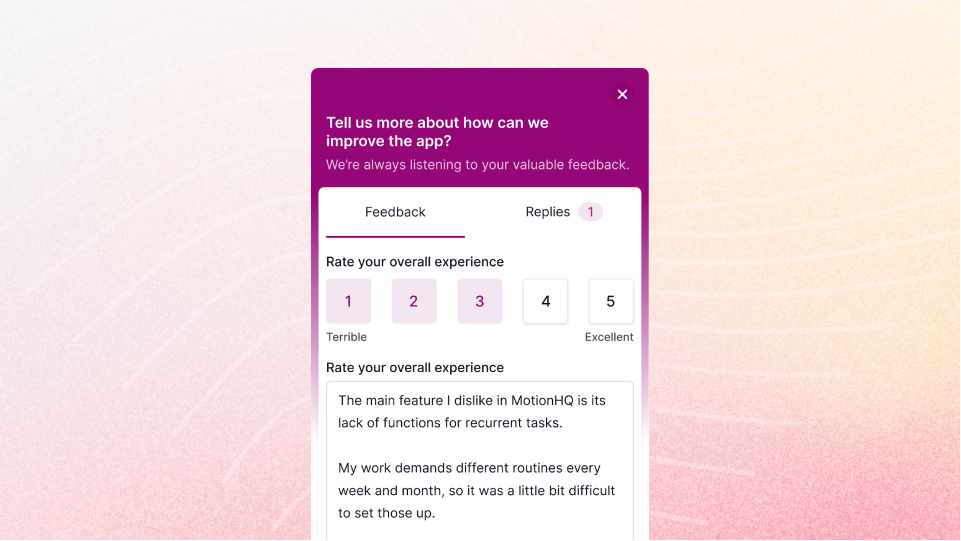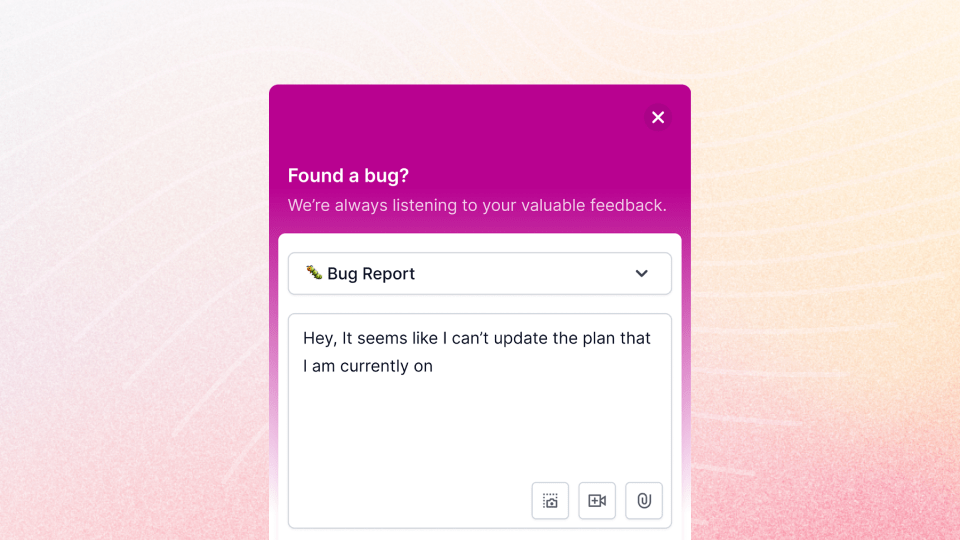Imagine you're conducting a survey to understand your customer's experience with your latest product, and you ask, "On a scale of 1 to 5, how satisfied are you with our product?"
You notice a glaring issue as the responses pour in - the answers only give you a numerical rating. It leaves you clueless about the reasons behind their satisfaction or dissatisfaction.
Here, the power of open-ended questions comes into play.
Incorporating open-ended questions in your surveys can help you significantly enhance the depth and quality of your insights.
In this comprehensive guide to open-ended questions, we'll explore how asking the right questions can open the door to deeper understanding. It'll enable you to uncover valuable information that can help shape your strategy and decision-making process.
So, let's start with the basics!
What Are Open-Ended Questions?
Open-ended questions are a type of inquiry that allows respondents to answer in their own words without being restricted to predefined options or a specific format. These questions encourage respondents to provide more detailed, thoughtful, and personalized responses. It can lead to a deeper understanding of their perspectives, opinions, and experiences.
Open-ended questions are precious in research and surveys as they enable researchers to gain insights into the reasoning behind respondents' answers, uncovering nuances that might be missed with close-ended questions. They also allow respondents to express themselves freely, revealing unexpected information and facilitating a more comprehensive topic analysis.
Examples of open-ended questions include:
- Tell us more about how we can improve the app.

- Can you describe a situation where you found our service particularly helpful?
- Found a bug? Tell us how we can fix it.

Ready to experience the power of open-ended questions firsthand?
Try Olvy's feedback widget and see the difference it makes in your engagement and understanding of your audience!
Open-ended questions often begin with words like "what," "why," "how," "when," "where," and "who," which prompt respondents to provide more detailed answers and share their thought processes.
Researchers and survey designers can use open-ended questions to gather rich qualitative data that can be instrumental in understanding complex issues, identifying patterns, and making informed decisions.
Difference Between Open-Ended And Close-Ended Questions
The critical difference between open-ended and close-ended questions lies in the nature of the responses they elicit and the kind of data they generate. Each type has its advantages and disadvantages, depending on the context and goals of the research or survey.
Here's a table of comparison between open-ended and close-ended questions:
When To Use Open-Ended Questions?
Open-ended questions are valuable in various situations, as they provide numerous benefits regarding data collection, understanding, and creativity. Here's when, how, and why you'd want to use open-ended questions:
1. Flexibility In Responses
Open-ended questions offer limitless potential for answers, granting respondents the liberty to communicate their thoughts and opinions without restrictions. In addition, this approach facilitates the collection of a wide array of perspectives, resulting in a more extensive understanding of the subject matter.
You can embrace the diversity of responses to obtain comprehensive insights. These insights contribute to informed decision-making and a better grasp of the complexities inherent in any given topic.
2. Gathering Detailed Information
Employing open-ended questions enables the collection of detailed, nuanced responses, fostering a deeper understanding of the subject matter. This approach leads to actionable insights, allowing for informed decision-making and addressing complex issues more effectively.
Open-ended questions capture the essence of individual perspectives, providing a comprehensive view of the topic.
3. Uncovering Unexpected Findings
Open-ended questions offer the opportunity to learn something unexpected and unique. Respondents are free to provide any answer, regardless of length or detail.
With the freedom of response, open-ended questions can reveal hidden opportunities, untapped potential, and novel ideas that might otherwise remain undiscovered. This wealth of diverse input contributes to the growth and enriches the collective understanding of the subject matter.
4. Addressing Complex Issues
Open-ended questions are ideal in situations demanding context, clarification, or elaboration. They empower respondents to respond comprehensively to intricate matters where straightforward yes/no or multiple-choice options fall short.
You can use open-ended questions to allow individuals to convey their thoughts and experiences fully. Thus, you can capture the complexity and nuances essential for understanding and addressing multifaceted issues. This approach leads to more informed decision-making and practical problem-solving strategies.
5. Gaining Insights Into Respondents' Thought Processes
The unrestricted format of open-ended questions offers insights into respondents' thought processes, including their:
- Logic
- Cognitive patterns
- Linguistic preferences
- Perspective
You can analyze these aspects to understand the viewpoints and motivations better. This in-depth knowledge enables more effective communication, fosters empathy, and helps address complex issues with greater sensitivity.
Open-ended questions serve as a window into respondents' minds, enhancing your ability to connect with and understand diverse perspectives in various situations.
6. Exploring Unknown Topics
When faced with a topic where your knowledge is limited and forming a hypothesis or designing closed questions proves challenging, open-ended questions serve as an effective solution. They allow you to delve into the subject without bias, paving the way for a more comprehensive understanding.
Challenges And Limitations Of Open-Ended Questions
Open-ended questions are essential for gathering rich, qualitative data in various settings like research, education, and customer feedback. However, these questions also come with their own set of challenges and limitations. Let's explore some of the most common difficulties and drawbacks.
1. Analysis Challenges
One primary challenge with open-ended questions is difficulty analyzing and interpreting the responses. In addition, unlike closed-ended questions, open-ended responses are not easily quantifiable, making them harder to process and summarize.
Possible Solutions
- Employ thematic analysis or coding techniques to categorize and quantify the data.
- Utilize text analysis software to assist in the data analysis process.
- Use open coding to group responses into categories based on common themes or ideas.
2. Respondent's Fatigue
Respondent fatigue is common when participants are asked to answer a series of open-ended questions. It can result in incomplete or vague answers, ultimately compromising the quality of the collected data.
Possible Solutions
- Limit the number of open-ended questions in your survey or interview.
- Structure your questionnaire to alternate between open-ended and closed-ended questions, keeping participants engaged.
- Provide clear instructions and context for each question to reduce confusion and maintain respondents' interest.
3. Time Constraints
Open-ended questions can be time-consuming for both the respondent and the researcher. Respondents may need more time to formulate their thoughts, while researchers must allocate more resources to analyze and interpret the data.
Possible Solutions
- Carefully select the number of open-ended questions to balance the need for in-depth information and time constraints.
- Provide participants with enough time to answer open-ended questions thoughtfully.
- Plan for additional time and resources in the research process to account for the analysis of open-ended responses.
Crafting Effective Open-Ended Questions
Creating engaging and thought-provoking open-ended questions is essential to gather valuable insights from respondents. Here are some guidelines to help you design effective open-ended questions that elicit meaningful responses.
1. Be Clear And Concise
Ensure that your questions are clearly worded and easy to understand. Avoid jargon, technical terms, or complex language that may confuse respondents. The question should be simple and to the point, allowing respondents to focus on providing their input.
2. Start With "How," "Why," Or "What."
Open-ended questions often begin with words like "how," "why," or "what" to encourage respondents to think profoundly and provide detailed responses. These words prompt respondents to share their thoughts, experiences, or opinions rather than just giving a yes or no answer.
3. Be Neutral And Unbiased
Your questions must be free from response bias and not lead respondents towards a specific answer. Avoid using emotionally charged or suggestive language that might influence the respondents' opinions. Instead, frame your questions neutrally to allow for diverse perspectives.
4. Avoid Double-barreled Questions
Double-barreled questions ask about two or more issues within a single question, confusing respondents. Instead, break down complex problems into more straightforward questions to ensure respondents can adequately address each aspect.
5. Provide Context Or Examples
Provide context or examples to clarify your question and help respondents understand what is being asked. It can help them focus their responses and provide more relevant information.
6. Encourage Elaboration
Phrase your questions to encourage respondents to elaborate on their thoughts and experiences. For example, instead of asking, "Did you like the product?" ask, "What did you like or dislike about the product?"
7. Test Your Questions
Before administering your survey or interview, test your open-ended questions on a small sample of your target audience. It can help identify issues or ambiguities and provide insights into how respondents interpret your questions.
8. Be Flexible And Adaptive
When conducting interviews or focus groups, be prepared to adapt your questions based on the responses you receive. For example, if a respondent provides an exciting or unexpected answer, follow up with probing questions to explore their perspective further.
Analyzing responses to open-ended questions can be a complex process due to the qualitative nature of the data. So let's understand how you can organize, interpret, and draw insights from the data collected through open-ended questions.
9. Organize And familiarize Yourself With Data
Begin by systematically organizing the responses, which may involve transcribing recordings, compiling written responses, and importing the data into a spreadsheet or qualitative data analysis software.
Familiarize yourself with the responses by reading them several times and identifying recurring ideas, exciting insights, or outliers.
10. Utilize Qualitative Data Analysis Software
Consider using qualitative data analysis software, such as NVivo or Atlas.ti, to streamline the organization, coding, and analysis of open-ended responses. In addition, these tools can provide visual representations of the data, making identifying patterns and relationships between themes easier.
11. Triangulate Findings And Create A Narrative
Compare your findings from open-ended questions with data collected through other methods, such as closed-ended questions or secondary data sources, to strengthen the validity of your conclusions.
Synthesize your findings by creating a narrative that explains the key themes, patterns, and insights from the open-ended responses, providing a clear and coherent account of the data and its implications for your research objectives or goals.
12. Visualize Data For Better Communication
Incorporate visual elements like charts, graphs, or word clouds to present your findings in a more engaging and accessible format.
Visual representations can highlight key insights and make the data more understandable to your audience, improving the overall communication of your results.
Ethical Considerations With Open-Ended Questions
It's essential to use open-ended questions responsibly and ethically. Ethical considerations ensure that we respect the autonomy and dignity of others while engaging in conversation. Addressing these aspects is crucial for maintaining trust and fostering healthy communication.
- Confidentiality: Respecting the privacy of individuals when discussing sensitive topics is paramount. Be mindful of shared information and uphold confidentiality when necessary, particularly in professional or therapeutic settings.
- Informed Consent: Ensure that conversation partners understand your questions' purpose and know how their responses may be used. Obtain their consent before proceeding with open-ended questions that might lead to disclosing personal or sensitive information.
- Cultural Sensitivity: Recognize that cultural differences can impact the understanding and interpretation of open-ended questions. Be aware of potential biases or assumptions that could be unintentionally offensive or intrusive. Adapt your language and approach to foster a respectful and inclusive environment.
Conclusion: Unlocking The Power Of Open-Ended Questions
Open-ended questions are a powerful tool that, when used effectively, can provide unparalleled insights into the minds of your respondents. Embrace the techniques and strategies discussed in this comprehensive guide to harness the power of open-ended questions to drive your research, business, or educational endeavors forward.
As you navigate the world of open-ended questions, consider leveraging Olvy to streamline your survey creation and analysis process.
Olvy offers a user-friendly platform for designing surveys that incorporate both open-ended and closed-ended questions. With Olvy's feedback widget, you can quickly and easily collect responses from your target audience, whether they are customers, research participants, or students.


